A paddle board is a wonderful companion for riding and having fun on the water. Apart from that, it is also used for water sport. The system of paddling is much like a canoe paddling. SUP surfing involves pushing or moving on a paddleboard with the aid of your paddle pole. But, most importantly you need to know how to choose a SUP board that will provide you good surfing on the water. This guide will help you to reach a resolution on purchasing a good paddle board as we are going to cover important facts about how to choose a paddle board.
Table of Contents
How to Choose a Paddle Board?
There are a lot of paddle boards on the market designed to meet diverse kinds of tastes. So, finding the right paddle board involves the study on some important features to look out for. The important features include the type of paddleboards, hull types, construction style physical properties (volume, weight capacity, thickness, width, and length), fin designs, accessories, etc. so if you are asking how to choose a standup paddleboard, you are at the right place. Look at the following six tips that will guide you through buying a paddle board.
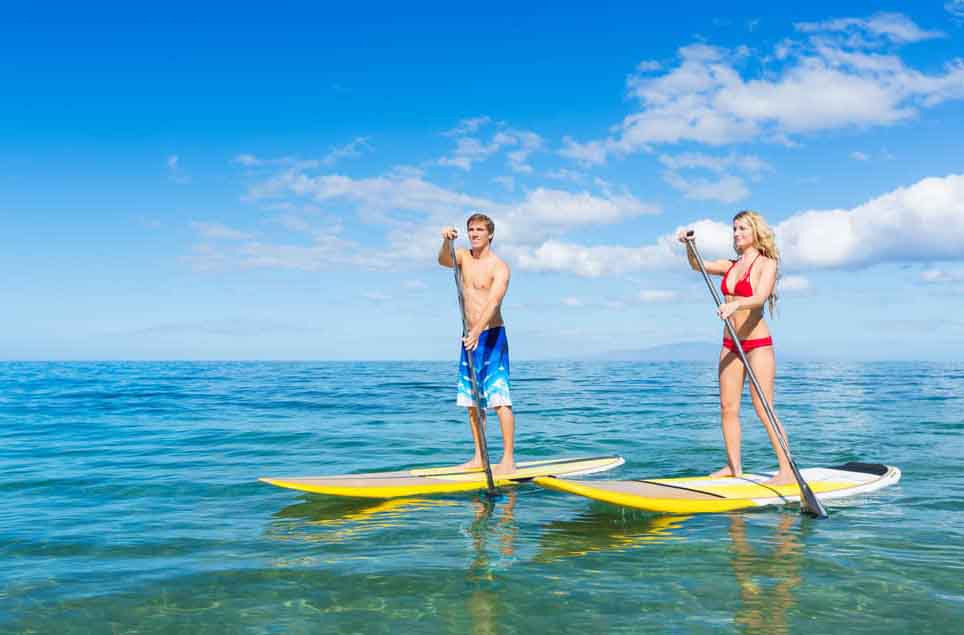
1. Understanding the types
2. Understanding the hull types
3. Knowing physical properties
4. Construction styles
5. Checking the fin designs
6. Choosing your accessories and outfit
Paddleboard Types
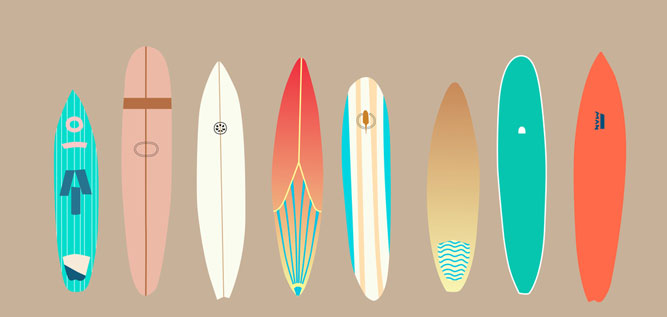
The question that first comes to the mind of a person willing to own a paddleboard is what paddleboard should I buy? Here is a look at the various types of paddleboards that will be suitable for the user.
1. Allround Boards
They are standard boards chosen by paddlers who look forward to catching up with the waves and paddle through calm waters. It is suitable for beginners who are just starting paddling new. They are wide and spacious for the paddler.
i. Uses and Advantages
- They are excellently stable for new freebies
- They can perform touring and surfing
- It can accommodate more than one weight
ii. Limitations
- Not good for water sporting events
2. Flatwater Boards
These paddle boards are designed for flatwater. You may also indulge in long-distance surfing following some cautions. It is also ideal for paddling on the open ocean. They are long and narrow than the all-around board. The structure of this paddle board is a combination of the round board and surf stand up paddle.
i. Uses and Advantages
- Great for paddling calm waters
- Used for long distance paddling or touring
- Stable enough to accommodate extra gears
- Also good for beginners
ii. Limitations
- It is hard to surf through unstable waters.
3. Race Sup Boards
As the name implies, this paddle board is designed and optimal for racing on the open ocean. The structure is longer, narrower, and sharper tip than a flatwater paddleboard. It is not suitable for a novice who is just starting to experience paddling as an adventure. These boards are a must-have for those looking forward to joining an upcoming surfing event.
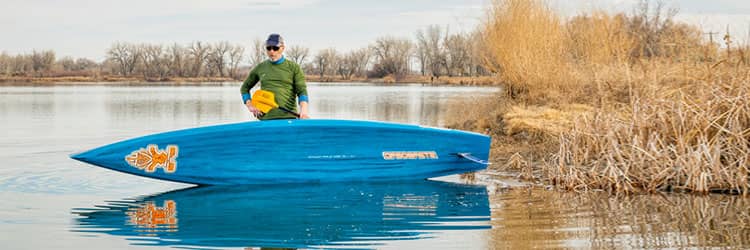
i. Uses and Advantages
- Excellent for paddling on flat water and touring
- Perfectly designed for racing and down winders
ii. Limitations
- Not suitable for beginners and family users
4. Surf Sup Boards
They serve as the best choice for those riding on the waves. It is shorter than other paddleboards. The nose and tail are designed to be pointed providing enough space for the movement of the SUP on water. Its narrow nature makes it capable of maneuvering in the surf. But the width is wide causing paddlers to fall off easily. It is meant for intermediate and advanced paddlers.
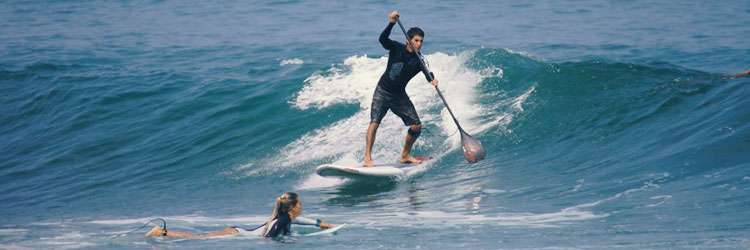
i. Uses and Advantages
- Easy maneuvering of boards on waves
- Used for water sports activities
- Used on faster water.
ii. Limitations
- Not suitable on flatwater
- Paddlers have the highest rate of falling off with this board.
5. Whitewater Boards
This is a river SUP board. The shape of the board is usually wide, 35-36 inches in width, and 9.6 inches in length. They are relatively shorter, making it easy for it to maneuver. The nose and tail are either widely rounded or closely rectangular. You need to practice to be able to use this board effectively.
i. Uses and Advantages
- It is better withstanding than sitting
- Used for white water sport
- You can perform stunts with this paddle.
ii. Limitations
- Most time it is not well balanced
- Racing is risky with this paddle unless you are a professional.
6. Windsurf Sup Boards
These boards are created to surf safely beating the wind and waves. They are different from other paddleboards in this sup board buying guide due to the attachment of sails to the board. This sail makes this type of board durable and versatile. In addition, the sails are light and powerful protecting the paddle from getting damaged by the wind.
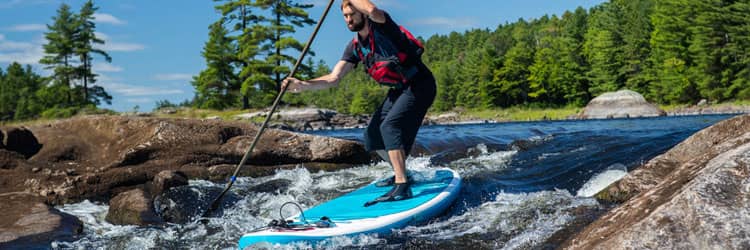
i. Uses and Advantages
- They are suitable to paddle through the water environment of strong wind and waves
- They are versatile
- They are durable
ii. Limitations
- Very risky for paddling on the open ocean if the sails eventually break.
Paddleboard Hull Types
Considering the hull type is an essential feature to look out for when buying a paddleboard. The two basic hull types for this standup paddleboard buying guide are elucidated below.
1. Planing Type
This type of hull is typically flat and wide. It is similar to a surfboard. It is best suitable for beginners to achieve a lot of fun as they are made to be versatile and provide great stability. This is a wonderful type of board for anyone who desires to achieve all they want.
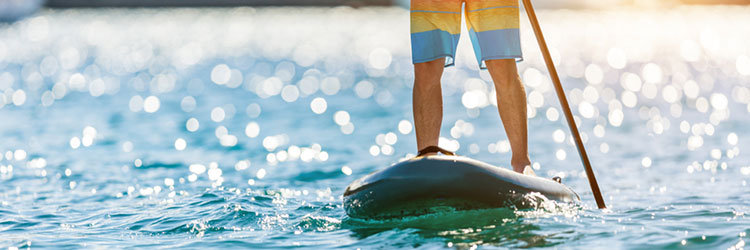
i. Advantages
- Provides enough stability
- You can experiment with a lot of options
- You can easily turn your paddle with this hull type.
ii. Limitations
- Pretty slow hull type on water
- The paddle has a rough landing on vertical drops
- Little provision for attachment of gears.
2. Displacement Type
This paddleboard type is prominent for racing and paddling long distances because of the pointed nose. It is similar to a kayak. You will notice that water is pushed around the nose and the sides of the SUP board by this hull type. This makes the paddleboard fast, smooth, and efficient.
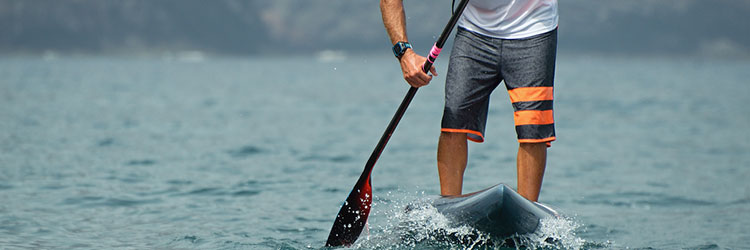
i. Advantages
- The paddleboard is fast on water
- Very efficient in its operation
- Less likely to be disrupted by obstacles.
ii. Limitations
- This type of paddle is harder to perform a turn
- Less stable than planning hull
- You can’t experiment with a lot of options.
Physical Properties
It’s a necessity to understand the properties of paddleboards. It will help you know how to pick the right paddle board for yourself. Here are the physical features to have at the back of your mind before owning a paddle board.
a) Volume and Weight Capacity
First and foremost, volume and weight are what to look for in a paddle board for this guide. This feature determines the buoyancy of your paddle board and its weight capacity. For instance, if the paddler with his gears weighs more than the capacity of the board, the efficiency will reduce making the board ride low on the water. It is measured in liters.
b) Length
If you are interested in getting a paddle board that can maneuver around water environments, have great speed ability and tracking ability, you need to choose a suitable length for the paddle board with the best-fitted length. The reasonable length a paddler should have is between the ranges of 7-14 inches.
c) Width
For this section, the basic information to acquire about the width of a paddleboard is that extra width will provide great stability, but can slow your board down. A beginner will enjoy the extra width as it is spacious enough to accommodate their mistakes. The standard width for a paddle board ranges from 28-33 inches.
d) Thickness
This is the final feature to consider in this guide. How thick is your paddle board? A thick board will accommodate weights according to its capacity. So if you are planning to paddle with your pet or some other thing that concerns you, you need to consider the thickness of your board. An increase in volume thickens the board and vice versa.
Construction Styles
One of the factors to consider when choosing a paddleboard is the style. You choose the style depending on your needs and lifestyle. In this guide, we have put together two major construction styles to look out for.
1. Inflatable Paddleboards
Absolutely, wonderful paddleboards that make life easier for the user. They are the easiest paddle boards to own. You can store or keep at home, and easily move it to and out of the water. To paddle this board, you need to pump it to the required PSI level.
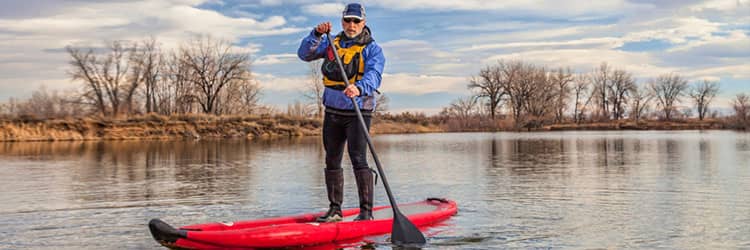
i. Advantages
- You can travel with it anywhere.
- They are absolutely durable
- This is the easiest type of paddle board to transport and store at home.
- Less expensive than the solid paddle boards
- Very suitable for beginners
- Comes with storage space.
ii. Limitations
- It is required to inflate and deflate your paddle boards before and after each paddling
- You will likely spend more time deflating than inflating your paddle boards.
- They are unstable as compared to solid paddle boards.
2. Solid Paddleboards
This construction style of paddle boards is meant for those who are after stability and durability. So if you haven’t found whether to buy an inflatable paddle board or a hard paddle one, you can check for this one because they are light in weight, pretty cheap, and affordable. Created from a variety of materials such as fiberglass, foam, kevlar, plastics, carbon fiber.
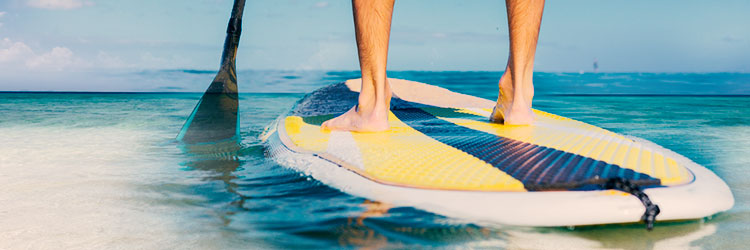
i. Advantages
- This paddle board are agile
- It has the best tracking, gliding, and control.
- Ideal choice for SUP racing, SUP surfing, and long-distance journey.
- It provides desirable performance compared to other models of paddleboards.
ii. Limitations
- You can’t move around with this board
- These paddle boards are expensive.
- They are not durable paddleboard
- Solid paddleboards are the most expensive among other models of paddleboards
In practice, there’re debates surrounding the supremacy of both types. To get a definitive answer as to the better one, you may learn the underlying differences between them.
Paddleboard Fin Arrangement
A good paddleboard is accompanied by standard fin configuration. This fins stabilizes and adds tracking to your paddle board. This sup board buying guide will enable you to make the right choice as we are going to discuss briefly on the popular and best fin configurations.
1. Single Fin
In paddling, a single fin system is your best setup for outside surfing and whitewater environment. It functions optimally when it deals with speed and paddling in a straight-line direction. But, if you want a definite pivot point for your turning, you need the large size of a single fin.
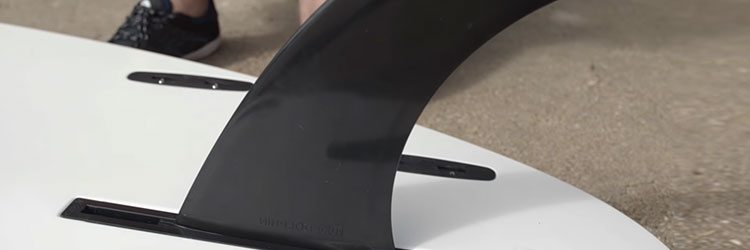
i. Advantages
- It is meant for experience or professional paddlers
- It is good when you need to paddle with great speed
- Enables you to perform long drawn out power turns or nose riding
- Creates pivot point while turning
- Good for outside surfing and whitewater environment
- Provides good tracking and the drag is reduced.
ii. Limitations
- Doesn’t provide enough balance or stability for your board
2. 2+1 (One Large + Two Small) Fins
This is kind of a 3 fin setup on a SUP comprising of two small sized front fins equal in shape called sidebites, located at either side of a large rear fin. This produces more power for paddling where you need more speed to move across the wave. But, this extra fins causes more drag for the board in water, thereby reducing your speed. In addition, it is recommended that the front fins should be a future fin box or FCS box to produce maximum flexibility.
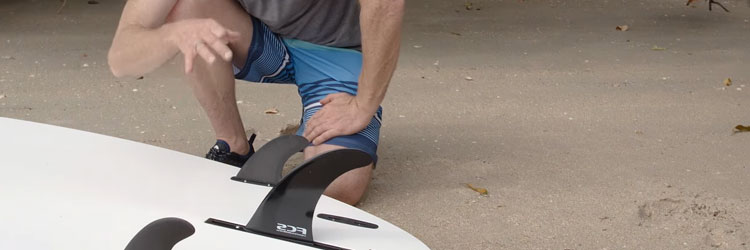
i. Advantages
- Good fin set for beginners who are out to learn to paddle.
- Provides balance and stability for the paddlers.
ii. Limitations
- Less speed compared to the single fin setup.
- Too much drag.
3. 3 Fins
Also known as a thruster, the 3 fin setup is considered as the best rounded and balanced. It is considered the most popular surfboard fin setup in the world for those who know how to choose SUP boards. All WCT and professional surfers prefer this fin setup to others. The fins work together to give you the best paddling adventure on the water.
i. Advantages
- Greater balance than the first two setup
- It has the ability to hold the line of the single fin setup
- Suitable for a beginner
- It provides more speed and liveliness to the paddle board.
ii. Limitations
- It drags the board.
4. Other Fins (Inflatable)
Fins for inflatable SUPs can have any of the above fin configurations, but they are different when it comes to their features. They may include two types of fins. One type of fin is flexible, rubber made and are affix to the board. The other type of fin is semi-rigid and are detachable.
i. Advantages
- They are suitable for inflatable boards
- They are durable
- They can be detached in case it needs a replacement.
ii. Limitations
- Doesn’t provide enough stability for the boards.
Accessories for Your Paddleboards
They are what you need to add to your gear. This paddleboard buying guide will help you spot the best accessory for your paddling experience.
1. Your Outfit
This simply means what you need to wear to enable you to have a smooth paddling. For the clothing, it varies depending on the season. During the summer, it is recommended to wear board shorts, a light-weight polo, a paddle cap to cover your face from the heat of the sun, and easy layer for the upper body against the breeze.
For the spring and autumn season, you’ll need an extra layer for the upper body, neoprene shoe boots, and a light jacket. Finally, for the winter season, you should get a well-crafted wetsuit, hand gloves, and neoprene boots. This will protect you against the extreme cold weather.
2. Tie-Downs
These accessories are stretchy cords or straps located at the front and or at the rear of the paddle board. Their function is to secure your bags, clothing and other attachments.
3. Mounts
This feature is created to help you attach your accessories to your SUP. There are many types of mounts available for your Sup. The popular ones are phone mounts; made to place your smartphone. Camera mounts; made to attach your action camera to the deck of your board. Fishing mounts; made to attach your fishing rod and paddle.
4. Paddle
This essential gear takes a similar shape of a canoe paddle with a blade shape tip. It propels your paddle board in the water. For you to have a good paddle, you need to consider the length, material, shape, offset and size of the blade.
5. Leash
This feature holds you down to your SUP and prevents the board from doing away with you if eventually, you fall off. This is very necessary considering the unpredictable nature of the wind and waves. It is attached to a strong point on the board while the other end is wrapped around the ankle or calf. A leash is either coiled or straight. The leash must be of the right length, specific for your SUP.
6. Pfd
Also known as a personal flotation device. It is an essential piece of gear designed to provide buoyancy to keep you afloat water. Sometimes people refer to it as a life jacket. Understanding the regulations and usability factors, you can go for a standard PFDs or inflatable PFDs depending on what you want to achieve. Other features to look out for are size, pockets, color/tabs, and buoyancy level. Considering all these, you may expect to get a suitable life jacket or PFD.
7. Car Rack
Finally, if you eventually have enough information about how to buy a paddle board. You will need a car rack. This is created to solve the puzzle of moving your SUP board from your home to the water. It is not safe to strap your board around your car. So all you need to do is to install the rack on top of your car. This can be best done by a car rack specialist.
Conclusion
If you follow this guide carefully, you will know what to look for when buying a paddle board. A good paddle board will make your paddling adventure full of fun and release you of the frustration that comes with testing different boards before reaching your desire.

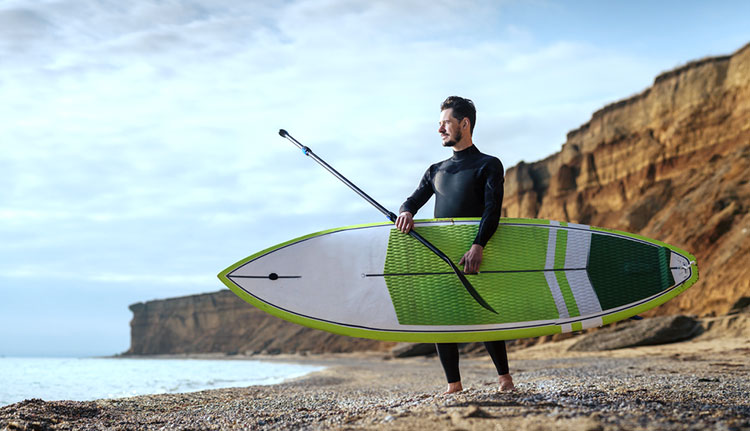
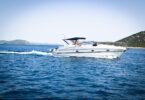

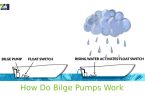
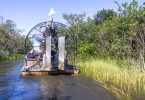
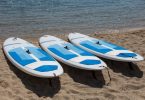

Leave a Comment